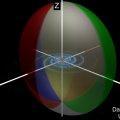Milky Way is like a "Squashed Beach Ball"
Milky Way Has a "Squashed Beach Ball" Dark Matter Halo January 6, 2010 Our galaxy is shaped like a flat spiral right? Not if you're talking about dark matter. Astronomers announced today that the Milky Way's dark matter halo, which represents about 70% of the galaxy's mass, is actually shaped like a squashed beachball. Dark matter is completely invisible, but it still obeys the law of gravity, so the existence of dark matter haloes, and their shape, can be inferred by monitoring the orbits of dwarf galaxies orbiting the much larger Milky Way.
Unfortunately, to determine the orbit of an object, you have to measure its position at several points in that orbit, and dwarf galaxies take about a billion years to go around the Milky Way. Astronomers just haven't been around long enough to watch even a fraction of a complete orbit. Luckily, they don't have to. Dwarf galaxies, just like their full-sized counterparts, and made of billions of stars. When the tidal forces from a big galaxy like the Milky Way act on a dwarf galaxy, the result is a streamer of stars that trace out the dwarf galaxy's orbit. By using data from huge all-sky surveys, a group of astronomers led by David Law at UCLA were able to reconstruct the orbit of the Sagittarius Dwarf Galaxy. There was just one problem: different parts of the dwarf galaxy had different orbits, which led to wildly different dark matter halo shapes.
Law and his colleagues Steven Majewski (University of Virginia) and Kathryn Johnston (Columbia University) solved this problem by allowing models of the dark matter halo to be "triaxial" – in other words, have different lengths in all three dimensions. The best model solution results in a halo shaped like a beach ball that has been squashed sideways.
“We expected some amount of flattening based on the predictions of the best dark-matter theories,” said Law, “but the extent, and particularly the orientation, of the flattening was quite unexpected. We're pretty excited about this, because it begs the question of how our galaxy formed in its present orientation.” Sagittarius is not the only dwarf galaxy orbiting the Milky Way, and Law and his colleagues plan to study the orbits of other dwarf galaxies to refine their model. "It will be important to see if these results hold up as precise orbits are measured for more of these galaxies. In the meantime, such a squashed dark-matter halo is one of the best explanations for the observed data.”

